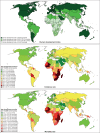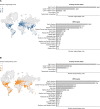Global challenges of radiotherapy for the treatment of locally advanced cervical cancer
- PMID: 35256434
- PMCID: PMC8921593
- DOI: 10.1136/ijgc-2021-003001
Global challenges of radiotherapy for the treatment of locally advanced cervical cancer
Abstract
Cervical cancer represents a significant portion of the global cancer burden for women, with low- and middle-income countries carrying the bulk of this burden. Additionally, underserved populations in countries with sufficient resources may have a higher incidence of cervical cancer and poorer outcomes. Concurrent chemoradiotherapy is the standard-of-care treatment for locally advanced cervical cancer, which includes patients with stage IB3 to IVA disease, and it is effective for many patients; however, cervical cancer-related mortality remains high. The critical nature of cervical cancer treatment is underscored by the recent launch of the World Health Organization global initiative to accelerate the elimination of cervical cancer using a triple-intervention strategy of increased vaccination, screening, and treatment. The initiative calls for 90% of all patients diagnosed with cervical cancer to receive the appropriate treatment, but to reach this global goal there are significant barriers related to radiotherapy that must be addressed. We discuss and review evidence of the lack of adherence to guideline-recommended treatment, brachytherapy underutilization, limited access to radiotherapy in low- and middle-income countries, as well as regional limitations within high-income countries, as the major barriers to radiotherapy treatment for locally advanced cervical cancer. We further review ways these barriers are currently being addressed and, in some cases, make additional recommendations to address these issues. Finally, despite receiving recommended treatments, many patients with locally advanced cervical cancer have a poor prognosis. With effective administration of current standards of care, the global community will be able to shift focus to advancing treatment efficacy for these patients. We review several types of therapies under clinical investigation that are additions to concurrent chemoradiotherapy, including immune checkpoint inhibitors, antiangiogenic agents, DNA repair inhibitors, human papillomavirus vaccines, and radiosensitizing nanoparticles.
Keywords: cervical cancer; radiation oncology.
© IGCS and ESGO 2022. Re-use permitted under CC BY-NC. No commercial re-use. Published by BMJ.
Conflict of interest statement
Competing interests: JM reports honoraria from Varian Medical Systems; consulting/advisory fees from the GOG foundation, NRG oncology, AstraZeneca, Agenus Bio; research funding from NRG Oncology; and travel/accommodation support from the GOG foundation. MDP reports honoraria and travel/accommodation support from Merck, Serono, and MSD; travel/accommodation support from Gador; and employment as a medical advisor for IQVIA.
Figures



References
-
- Oncology NEWS International . NCI urges chemo-RT combination for invasive cervical cancer, 1999. Available: https://www.cancernetwork.com/view/nci-urges-chemo-rt-combination-invasi... [Accessed 24 Aug 2021].

